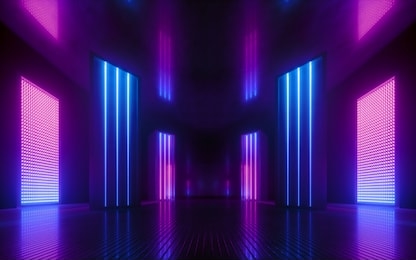Publisher: Supplier of LED Display Time: 2022-03-25 14:55 Views: 1636
What is the effect of high temperature operation on the led display? With the increasing use of LED displays today, in order to maximize the advantages of the display, users should have a certain understanding of the maintenance of the LED display. Whether it is an indoor LED display or an outdoor LED display, heat will be generated during operation, and the generated heat will cause the temperature of the LED display to rise. However, do you know what effect the high temperature operation has on the led display? Below LCF sends a small editor to explain it to you one by one.
Under normal circumstances, indoor LED displays generate less heat due to low brightness, and can dissipate heat naturally. However, the outdoor LED electronic display generates a lot of heat due to its high brightness, which needs to be dissipated by air conditioners or axial fans. Since the LED display is an electronic product, the increase in temperature will affect the light attenuation of the LED electronic display lamp beads, thereby reducing the working efficiency of the driver IC and shortening the service life of the LED display.

1. The working temperature of the led display exceeds the bearing temperature of the chip, which will rapidly reduce the luminous efficiency of the led display, resulting in obvious light decay and damage; the led display is mostly encapsulated with transparent epoxy resin, if the junction temperature exceeds At the solid phase transition temperature (usually 125°C), the encapsulation material will change to a rubbery state and the thermal expansion coefficient will rise sharply, causing the LED display to open and fail.
2.the high temperature will affect the light decay of the LED display. The life of the led display is manifested by its light decay, that is, the brightness will become lower and lower after a long time, until it goes out. It is usually defined that the time when the luminous flux of the LED display screen decays by 30 is its life. High temperature is the main source of light failure of LED display and shortening the life of LED display. The light decay of different brands of LED displays is different. Usually, LED display manufacturers will give a set of standard light decay curves. The luminous flux attenuation of the LED display screen caused by high temperature is irreversible. The luminous flux of the LED display screen before irreversible light attenuation occurs, which is called the "initial luminous flux" of the LED display screen.
3. the increase in temperature will reduce the luminous efficiency of the LED display. As the temperature increases, the concentration of electrons and holes will increase, the forbidden band width will decrease, and the electron mobility will decrease; as the temperature increases, the radiative recombination probability of electrons and holes in the potential well will decrease, resulting in non-radiative recombination (producing heat), thereby reducing the internal quantum efficiency of the LED display; the increase in temperature causes the blue light wave peak of the chip to shift to the long wave direction, so that the emission wavelength of the chip does not match the excitation wavelength of the phosphor, and it will also cause the external light of the white LED display. The extraction efficiency decreases; as the temperature rises, the quantum efficiency of the phosphor decreases, the light output decreases, and the external light extraction efficiency of the LED display decreases; the performance of the silica gel is greatly affected by the ambient temperature. As the temperature increases, the thermal stress inside the silica gel increases, resulting in a decrease in the refractive index of the silica gel, thereby affecting the light efficiency of the LED display.
4. the effect of temperature on the luminous wavelength (light color) of the LED display. The luminous wavelength of LED display can generally be divided into peak wavelength and dominant wavelength. The peak wavelength is the wavelength of light intensity, and the dominant wavelength can be determined by the X and Y chromaticity coordinates, reflecting the color perceived by the human eye. Obviously, the change of the luminous wavelength of the LED display caused by the junction temperature will directly cause the human eye to have different perceptions of the luminous color of the LED display. For an LED display device, the value of the forbidden band width of the material in the light-emitting region directly determines the wavelength or color of the device's light emission. As the temperature increases, the forbidden band width of the material will decrease, resulting in a longer wavelength of light emission of the device and a red shift of the color.
5.the high temperature will limit the injection current of the led display. When purchasing an LED display, pay attention to choosing the LED display chip brand, packaging manufacturer, driver IC brand, and switching power supply brand. The quality of the brand will affect the product quality of the LED display itself, and the brand with a high degree of The product itself generates less heat and can better control the temperature of the LED display, thereby extending the service life of the LED display.
6. Excessive temperature will cause the LED display to be completely damaged. The operating temperature of the LED display exceeds the bearing temperature of the chip, which will rapidly reduce the luminous efficiency of the LED display, resulting in obvious light attenuation and damage. Most led displays are encapsulated with transparent epoxy. If the junction temperature exceeds the solid phase transition temperature (usually 125°C), the encapsulation material will become rubber, and the thermal expansion coefficient will rise sharply, which will lead to open-circuit failure of the LED display.
LED display has great development prospects because of its advantages of energy saving, environmental protection, long life and so on. The LED display is more sensitive to temperature: it will affect the life, light efficiency, color, etc. of the LED display. So the right temperature is crucial for the LED display.
The above is the impact of high temperature operation on the led display screen sorted out by LCF. You are welcome to make additions or corrections. If you want to buy LED displays, you can also contact us from LCF manufacturers!




